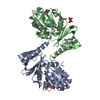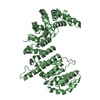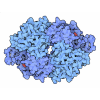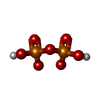[English] 日本語
 Yorodumi
Yorodumi- PDB-2e2x: Sec14 Homology Module of Neurofibromin in complex with phosphatit... -
+ Open data
Open data
- Basic information
Basic information
| Entry | Database: PDB / ID: 2e2x | ||||||
|---|---|---|---|---|---|---|---|
| Title | Sec14 Homology Module of Neurofibromin in complex with phosphatitylethanolamine | ||||||
 Components Components | Neurofibromin | ||||||
 Keywords Keywords | SIGNALING PROTEIN / Sec14 / PH superfold / PE / CRAL-TRIO domain | ||||||
| Function / homology |  Function and homology information Function and homology informationpositive regulation of mast cell apoptotic process / negative regulation of Rac protein signal transduction / regulation of glial cell differentiation / observational learning / negative regulation of Schwann cell migration / Schwann cell migration / amygdala development / vascular associated smooth muscle cell migration / Schwann cell proliferation / negative regulation of mast cell proliferation ...positive regulation of mast cell apoptotic process / negative regulation of Rac protein signal transduction / regulation of glial cell differentiation / observational learning / negative regulation of Schwann cell migration / Schwann cell migration / amygdala development / vascular associated smooth muscle cell migration / Schwann cell proliferation / negative regulation of mast cell proliferation / mast cell apoptotic process / gamma-aminobutyric acid secretion, neurotransmission / vascular associated smooth muscle cell proliferation / negative regulation of Schwann cell proliferation / glutamate secretion, neurotransmission / negative regulation of leukocyte migration / mast cell proliferation / forebrain morphogenesis / regulation of cell-matrix adhesion / hair follicle maturation / regulation of blood vessel endothelial cell migration / camera-type eye morphogenesis / cell communication / smooth muscle tissue development / negative regulation of neurotransmitter secretion / negative regulation of oligodendrocyte differentiation / sympathetic nervous system development / myeloid leukocyte migration / peripheral nervous system development / myelination in peripheral nervous system / phosphatidylcholine binding / negative regulation of Ras protein signal transduction / metanephros development / phosphatidylethanolamine binding / positive regulation of extrinsic apoptotic signaling pathway in absence of ligand / collagen fibril organization / regulation of long-term synaptic potentiation / regulation of postsynapse organization / endothelial cell proliferation / regulation of bone resorption / artery morphogenesis / neural tube development / adrenal gland development / negative regulation of neuroblast proliferation / forebrain astrocyte development / negative regulation of protein import into nucleus / regulation of synaptic transmission, GABAergic / spinal cord development / negative regulation of astrocyte differentiation / negative regulation of vascular associated smooth muscle cell migration / negative regulation of endothelial cell proliferation / pigmentation / negative regulation of osteoclast differentiation / Rac protein signal transduction / oligodendrocyte differentiation / RAS signaling downstream of NF1 loss-of-function variants / negative regulation of cell-matrix adhesion / extrinsic apoptotic signaling pathway via death domain receptors / neuroblast proliferation / positive regulation of GTPase activity / regulation of angiogenesis / regulation of ERK1 and ERK2 cascade / Schwann cell development / negative regulation of fibroblast proliferation / skeletal muscle tissue development / negative regulation of stem cell proliferation / positive regulation of vascular associated smooth muscle cell proliferation / negative regulation of MAPK cascade / positive regulation of endothelial cell proliferation / extrinsic apoptotic signaling pathway in absence of ligand / extracellular matrix organization / GTPase activator activity / osteoclast differentiation / negative regulation of cell migration / negative regulation of angiogenesis / stem cell proliferation / phosphatidylinositol 3-kinase/protein kinase B signal transduction / wound healing / liver development / regulation of long-term neuronal synaptic plasticity / cerebral cortex development / brain development / visual learning / cognition / long-term synaptic potentiation / protein import into nucleus / Regulation of RAS by GAPs / osteoblast differentiation / positive regulation of neuron apoptotic process / MAPK cascade / presynapse / cellular response to heat / heart development / regulation of gene expression / actin cytoskeleton organization / neuron apoptotic process / fibroblast proliferation / angiogenesis / Ras protein signal transduction / response to hypoxia Similarity search - Function | ||||||
| Biological species |  Homo sapiens (human) Homo sapiens (human) | ||||||
| Method |  X-RAY DIFFRACTION / X-RAY DIFFRACTION /  SYNCHROTRON / SYNCHROTRON /  MOLECULAR REPLACEMENT / Resolution: 2.5 Å MOLECULAR REPLACEMENT / Resolution: 2.5 Å | ||||||
 Authors Authors | D'Angelo, I. / Welti, S. / Scheffzek, K. | ||||||
 Citation Citation |  Journal: J.Mol.Biol. / Year: 2007 Journal: J.Mol.Biol. / Year: 2007Title: The sec14 homology module of neurofibromin binds cellular glycerophospholipids: mass spectrometry and structure of a lipid complex Authors: Welti, S. / Fraterman, S. / D'Angelo, I. / Wilm, M. / Scheffzek, K. #1:  Journal: Embo Rep. / Year: 2006 Journal: Embo Rep. / Year: 2006Title: A novel bipartite phospholipid-binding module in the neurofibromatosis type 1 protein Authors: D'Angelo, I. / Welti, S. / Bonneau, F. / Scheffzek, K. | ||||||
| History |
|
- Structure visualization
Structure visualization
| Structure viewer | Molecule:  Molmil Molmil Jmol/JSmol Jmol/JSmol |
|---|
- Downloads & links
Downloads & links
- Download
Download
| PDBx/mmCIF format |  2e2x.cif.gz 2e2x.cif.gz | 117.4 KB | Display |  PDBx/mmCIF format PDBx/mmCIF format |
|---|---|---|---|---|
| PDB format |  pdb2e2x.ent.gz pdb2e2x.ent.gz | 90.3 KB | Display |  PDB format PDB format |
| PDBx/mmJSON format |  2e2x.json.gz 2e2x.json.gz | Tree view |  PDBx/mmJSON format PDBx/mmJSON format | |
| Others |  Other downloads Other downloads |
-Validation report
| Summary document |  2e2x_validation.pdf.gz 2e2x_validation.pdf.gz | 910.7 KB | Display |  wwPDB validaton report wwPDB validaton report |
|---|---|---|---|---|
| Full document |  2e2x_full_validation.pdf.gz 2e2x_full_validation.pdf.gz | 939.7 KB | Display | |
| Data in XML |  2e2x_validation.xml.gz 2e2x_validation.xml.gz | 25.1 KB | Display | |
| Data in CIF |  2e2x_validation.cif.gz 2e2x_validation.cif.gz | 33.1 KB | Display | |
| Arichive directory |  https://data.pdbj.org/pub/pdb/validation_reports/e2/2e2x https://data.pdbj.org/pub/pdb/validation_reports/e2/2e2x ftp://data.pdbj.org/pub/pdb/validation_reports/e2/2e2x ftp://data.pdbj.org/pub/pdb/validation_reports/e2/2e2x | HTTPS FTP |
-Related structure data
| Related structure data |  2d4qS S: Starting model for refinement |
|---|---|
| Similar structure data |
- Links
Links
- Assembly
Assembly
| Deposited unit | 
| |||||||||
|---|---|---|---|---|---|---|---|---|---|---|
| 1 |
| |||||||||
| Unit cell |
| |||||||||
| Components on special symmetry positions |
|
- Components
Components
| #1: Protein | Mass: 31755.285 Da / Num. of mol.: 2 / Fragment: NF1 Source method: isolated from a genetically manipulated source Source: (gene. exp.)  Homo sapiens (human) / Plasmid: pET / Species (production host): Escherichia coli / Production host: Homo sapiens (human) / Plasmid: pET / Species (production host): Escherichia coli / Production host:  #2: Chemical | #3: Chemical | #4: Water | ChemComp-HOH / | |
|---|
-Experimental details
-Experiment
| Experiment | Method:  X-RAY DIFFRACTION / Number of used crystals: 1 X-RAY DIFFRACTION / Number of used crystals: 1 |
|---|
- Sample preparation
Sample preparation
| Crystal | Density Matthews: 2.91 Å3/Da / Density % sol: 57.7 % |
|---|---|
| Crystal grow | Temperature: 291 K / Method: vapor diffusion, hanging drop / pH: 6 Details: 5% PEG 4000, 0.25M NaPP, MES, pH 6, VAPOR DIFFUSION, HANGING DROP, temperature 291K |
-Data collection
| Diffraction | Mean temperature: 100 K |
|---|---|
| Diffraction source | Source:  SYNCHROTRON / Site: SYNCHROTRON / Site:  ESRF ESRF  / Beamline: ID14-4 / Wavelength: 0.9537 Å / Beamline: ID14-4 / Wavelength: 0.9537 Å |
| Detector | Type: ADSC QUANTUM 4 / Detector: CCD / Date: Feb 6, 2005 |
| Radiation | Monochromator: three diamond + Khozu / Protocol: SINGLE WAVELENGTH / Monochromatic (M) / Laue (L): M / Scattering type: x-ray |
| Radiation wavelength | Wavelength: 0.9537 Å / Relative weight: 1 |
| Reflection | Resolution: 2.5→15 Å / Num. obs: 52887 / % possible obs: 97.9 % / Observed criterion σ(F): 0 / Observed criterion σ(I): 0 / Rmerge(I) obs: 0.07 / Rsym value: 0.152 |
| Reflection shell | Resolution: 2.5→2.6 Å / Mean I/σ(I) obs: 4.1 / Num. unique all: 5687 / Rsym value: 0.334 / % possible all: 95.3 |
- Processing
Processing
| Software |
| |||||||||||||||||||||
|---|---|---|---|---|---|---|---|---|---|---|---|---|---|---|---|---|---|---|---|---|---|---|
| Refinement | Method to determine structure:  MOLECULAR REPLACEMENT MOLECULAR REPLACEMENTStarting model: PDB ENTRY 2D4Q Resolution: 2.5→15 Å / Cross valid method: THROUGHOUT / σ(F): 0 / Stereochemistry target values: Engh & Huber
| |||||||||||||||||||||
| Refinement step | Cycle: LAST / Resolution: 2.5→15 Å
|
 Movie
Movie Controller
Controller












 PDBj
PDBj











